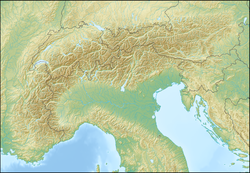Earthquake of 1348
| Date | 25 January 1348 |
|---|---|
| Magnitude | 6.9 |
| Epicenter | 46°22′N 13°35′E / 46.37°N 13.58°ECoordinates: 46°22′N 13°35′E / 46.37°N 13.58°E |
| Areas affected | Italy (Friuli-Venezia Giulia) Austria (Carinthia) |
| Max. intensity | X (Extreme) |
| Casualties | 10,000 |
The 1348 Friuli earthquake, centered in the South Alpine region of Friuli, was felt across Europe on 25 January. The quake hit in the same year that the Great Plague ravaged Italy. According to contemporary sources, it caused considerable damage to structures; churches and houses collapsed, villages were destroyed and foul odors emanated from the earth.
The epicenter was located east of Tolmezzo, Venzone and Gemona, with a seismic intensity of eight to nine according to the European Macroseismic Scale (approximately measured 6.9 on the Richter scale). Most of the damage reported was in Northern Italy (including places as far away as Pisa and Naples), in the present-day Friuli-Venezia Giulia region, in the adjacent provinces of Belluno, Vicenza and Verona up to Lombardy and Venice, as well as in Carinthia and Carniola (in nowadays Slovenia) to the north and east. Aftershocks occurred until 5 March.
Striking in the early afternoon, the earthquake caused hundreds of casualties and destroyed numerous buildings. In Udine, the castle and the cathedral were severely damaged. In Carinthia, the town of Villach and numerous surrounding villages were largely destroyed by a major landslide followed by a flood of the Gail River. Even in Rome the earthquake allegedly took a toll: considerable damage was sustained by the Basilica of Santa Maria Maggiore; in the Torre delle Milizie, an upper floor crumbled, and the structure assumed the slight tilt it retains today. The sixth-century basilica of Santi Apostoli was so utterly ruined that it was left in an abandoned state for a generation.
...
Wikipedia

